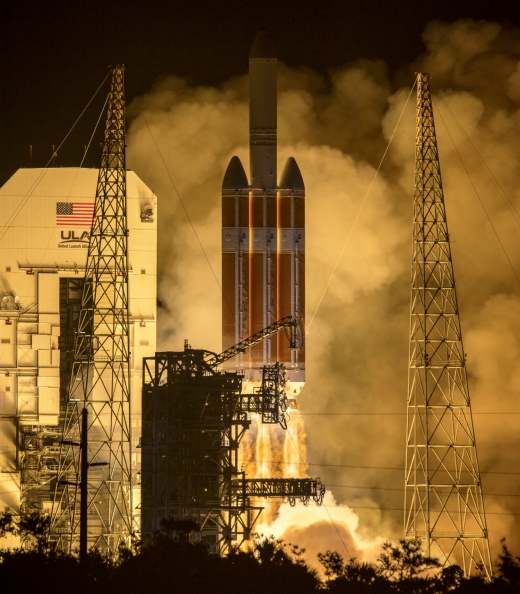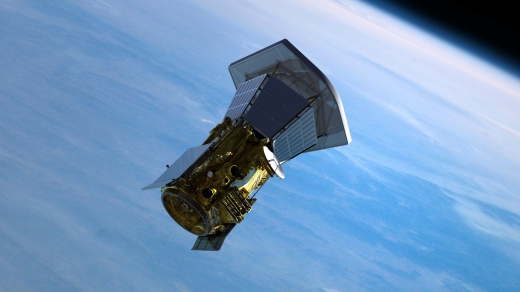The first thing I did when I heard about the Parker Solar Probe’s successful launch (0731 UTC Sunday) was to double-check the spacecraft’s projected velocity when it makes its closest approach to the Sun. I always think in terms of high speed when contemplating operations close to our star, the legacy of the two Helios missions, which at present hold the record as fastest man-made objects. Placed in highly elliptical orbits after their launches in 1974 and 1976, the Helios spacecraft managed a sizzling 70 kilometers per second.
The Helios missions were a joint venture between what was then West Germany’s space agency and NASA, the craft themselves built by German aerospace firm Messerschmitt-Bölkow-Blohm. Helios 2 flew closer to the Sun by about 3 million kilometers, closing to 0.29 AU (43 million kilometers), which took it inside the orbit of Mercury. The Parker Solar Probe ups the ante considerably, with an eventual closest approach of just 6.1 million kilometers.
The spacecraft at that point will be moving at roughly 192 kilometers per second, easily eclipsing the Helios record. Now imagine if we could put a spacecraft at these speeds on a course for Alpha Centauri. Context is everything, and what is truly a blistering pace in comparison to our previous records turns out to be a good deal less than 1 tenth of one percent of lightspeed when pondered in interstellar terms. It gets us to Centauri A/B in 6000 years.

Image: The United Launch Alliance Delta IV Heavy rocket launches NASA’s Parker Solar Probe to touch the Sun, Sunday, Aug. 12, 2018, from Launch Complex 37 at Cape Canaveral Air Force Station, Florida. Parker Solar Probe is humanity’s first-ever mission into a part of the Sun’s atmosphere called the corona. Here it will directly explore solar processes that are key to understanding and forecasting space weather events that can impact life on Earth. Credit: NASA/Bill Ingalls.
We’ll track the Parker Solar Probe with great interest over the course of its seven year mission, which gets interesting quickly as the craft heads toward Venus for the first of seven flybys of that planet, using Venus’ gravity to tighten up its solar orbit. By November, the Parker Solar Probe will be positioned to pass through the Sun’s corona with the first of its projected 24 total passes by the Sun. Bear in mind that the corona is more than 300 times hotter than the Sun’s surface.
We have an 11-centimeter thick carbon-carbon composite shield to thank for making operations in this environment possible, one whose front surface is capable of withstanding temperatures beyond 1300 degrees Celsius. This advanced thermal protection will keep four suites of instruments alive to study plasma and energetic particles, magnetic fields and the solar wind.
That last point has great relevance to our discussions on Centauri Dreams, namely the methods we may one day use for fast transportation around the Solar System by way of building the infrastructure we’ll need for interstellar flight. The more we learn about the solar wind, which can hit 800 kilometers per second, the more we’ll understand the variables that may help us harness it through variously designed magnetic sails. That assumes, of course, that this highly mutable and unpredictable flow is manageable enough to navigate with such craft.

Image: Artist’s impression of the Parker Solar Probe spacecraft leaving Earth, after separating from its launch vehicle and booster rocket, bound for the inner solar system and an unprecedented study of the Sun. Credit: JHU/APL.
I’ve commented before in these pages that there are also interesting implications for future ‘sundiver’ missions in the Parker Solar Probe. In these concepts, a solar sail, perhaps furled behind an occulter such as a small asteroid, would be taken as close as possible to the Sun before being unfurled at perihelion to achieve the highest possible acceleration. If a mission like that is ever to happen, we’ll need the kind of data the Parker Solar Probe delivers as we learn how to operate in an environment as extreme as any spacecraft has ever encountered.
The Parker Solar Probe’s solar arrays have already deployed. Immediately ahead for the spacecraft is deployment of its high-gain antenna and magnetometer boom, as well as the first of a two-part deployment of its electric field antennas. The instrument testing period begins in early September and continues for four weeks, after which science operations will begin.



This post had me thinking of a Sundiver mission for which I found it hard to research in the literature.. Has there been a mission proposal / calculations done for a Sundiver/Bolo/Skyhook type centrifugal launch system with tethered release happening at minimum solar periapsis for interstellar capable velocities? And what sort of velocities could such a craft expect ?
Solar Sails: A Novel Approach to Interplanetary Travel by Vulpetti, Johnson, and Matloff, has a chapter on very fast solar sails, with details of a variety of sundiver trajectories. Cruise velocities over 120km/s are achievable. Part of that performance is also based on sail material and loading, as well as the benefits of a close approach to the sun. There is even a section about the expected issues in the environment close to the sun.
The skyhook/tether idea for acceleration at perihelion is very interesting. The materials will need to withstand the intense radiation, but certainly food for thought. You certainly get the advantage of the Oberth effect, which in this case, I’m guessing, is the reduced loss of angular momentum needed to gain the extra velocity compared with the skyhook operating at 1 AU from a near standing start.
On a more general note about skyhooks, one rarely reads about the use of multiple hooks to manipulate spacecraft velocities and trajectories. The savings in propellant and time by using a skyhook/tether to make both velocity and trajectory changes would be valuable once the system was set up. The accuracy of rendezvous with the skyhooks would be paramount, but hardly impossible given today’s extraordinary capabilities with space probes, plus onboard computations to adjust the flight.
Have you looked into this at all?
I drew a sketch of the type of setup I was envisioning..
Although it seems to be turning into a bit of a Uni-physics lesson
http://CoSketch.com/Saved/pkjeD6tD
Large Mass A would be the centrifugal fulcrum. The Launch Mass B would be located in a positioned within some type of gyroscopic centrifugal counterbalancing mechanism which is at the end of the space tether. The whole system (all masses, tether, gyroscope etc) could be ‘spun-up’ many times on approach to solar periapsis with hopefully minimal G’s felt in the launch craft.
My thoughts on this were not that this craft would be a solar sail (although upon launch a sail unfurl would make sense)
To get the best performance using a solar sail near perihelion, ideally a high acceleration to get the Oberth Effect is needed. To me, this suggests using sails that ablate, providing thrust from “propellant” emitted from their surfaces. After this stage, then pure photonic propulsion will take over. Do the extra mass and sail complexity make operational sense? I don’t know.
From such sundiver missions, I hope the Parker Solar Probe provides data on whether it is safe to enter the Corona, and what protection such missions will need. And someday, when our technology is farther advanced, there will be a mission to touch the surface…to retrieve the golden apples of the sun.
It occurs to me that those metamaterial sails that can switch between reflection and refraction might be good for sundiver sail missions. Refraction to accelerate towards perihelion, reflection to accelerate away from perihelion.
He who laughs last – launches best: Parker Solar Probe mission a testament to faith
by Jason Rhian
August 13, 2018
http://www.spaceflightinsider.com/editorial/he-who-laughs-last-launches-best-parker-solar-probe-mission-a-testament-to-faith/
The scientific method, actually.
So it’s gonna get in the corona in about three months?
Yes. The first pass will reach the corona 15 million miles above the sun’s surface. It will then make more passes over the next 7 years using Venus’ gravity to reduce the distance to 3.8 million miles above the surface at its closest approach. So we get the first data quite soon, but it will be complemented over the full mission.
https://apod.nasa.gov/apod/ap180815.html
Launch of the Parker Solar Probe
Image Credit & Copyright: John Kraus
Explanation: When is the best time to launch a probe to the Sun? The now historic answer — which is not a joke because this really happened this past weekend — was at night. Night, not only because NASA’s Parker Solar Probe’s (PSP) launch window to its planned orbit occurred, in part, at night, but also because most PSP instruments will operate in the shadow of its shield — in effect creating its own perpetual night near the Sun.
Before then, years will pass as the PSP sheds enough orbital energy to approach the Sun, swinging past Venus seven times. Eventually, the PSP is scheduled to pass dangerously close to the Sun, within 9 solar radii, the closest ever. This close, the temperature will be 1,400 degrees Celsius on the day side of the PSP’s Sun shield — hot enough to melt many forms of glass. On the night side, though, it will be near room temperature.
A major goal of the PSP’s mission to the Sun is to increase humanity’s understanding of the Sun’s explosions that impact Earth’s satellites and power grids. Pictured is the night launch of the PSP aboard the United Launch Alliances’ Delta IV Heavy rocket early Sunday morning.
Microwaves from Solar Flares
By Susanna Kohler on 15 August 2018
The Sun is a rather well-studied star, so it’s always exciting when we get the opportunity to observe it in a new way. One such opportunity is upcoming, via the Parker Solar Probe that just launched last week. But while we wait for that new view of the Sun, we have another one to examine: the Sun in microwaves.
https://aasnova.org/2018/08/15/microwaves-from-solar-flares/
Carrington Event Solar Storm had Power of 10 Billion Atomic Bombs.
weather.com/news/trending/video/carrington-event-solar-storm-had-power-of-10-billion-atomic-bombs
Surprisingly strong G3-class geomagnetic storm creates strong current of electricity moving underground.
By Strange Sounds – Aug 28,
http://strangesounds.org/2018/08/surprisingly-strong-g3-class-geomagnetic-storm-creates-strong-current-of-electricity-moving-underground.html
“Earth’s magnetic field is quieting, finally, almost 48 hours after a surprisingly strong geomagnetic storm sparked auroras seen from the Arctic Circle to the continental USA. And during the surprisingly strong G3-class geomagnetic storm of Aug. 26th, there was action underground as well. Strong electric currents moving through the soils have been detected in the ground of Norway, which were about 10 times stronger than normal. Let’s just say that’s a pretty rare during solar minimum!”
Another probe mission that will be getting rather close to Sol…
http://www.planetary.org/explore/the-planetary-report/voyage-to-mercury.html
Wow! Less than two months after its launch, Parker just made its first gravity-assist flyby of Venus!
http://www.americaspace.com/2018/10/03/parker-solar-probe-conducts-first-venus-fly-by-on-course-for-the-sun-in-late-october/
Express elevator to Hell: Missions to explore the Sun’s nearest neighbor
Later this month Europe will launch BepiColombo, the newest mission to the innermost planet, Mercury. Dwayne Day recounts some of the efforts after the Mariner 10 flybys in the 1970s to send followup missions to the planet, overcoming technical and other issues.
Monday, October 8, 2018
http://thespacereview.com/article/3582/1
Emily Lakdawalla • October 22, 2018
Following perfect launch, BepiColombo takes self-portraits from space
http://www.planetary.org/blogs/emily-lakdawalla/2018/bepicolombo-launch-self-portraits.html